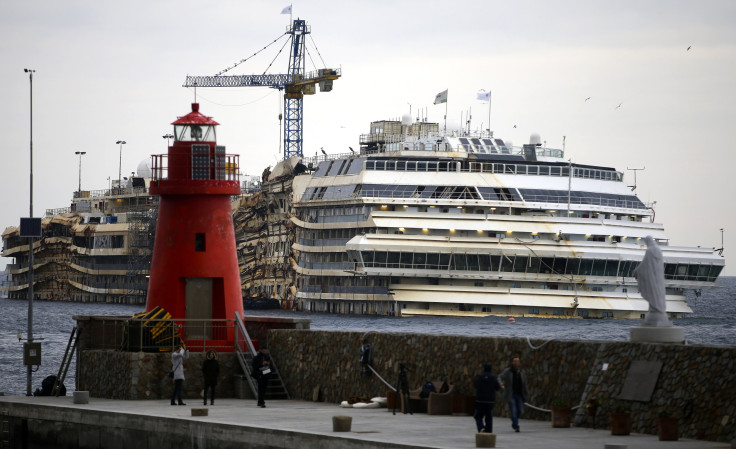As The Costa Concordia Is Raised, Blame Continues To Be Passed

Two and a half years after it sank off the Italian coast, the wrecked cruise ship Costa Concordia is floating again. On Monday, the first day of the ship’s weeklong, $2 billion raising operation, the memory of the disaster, the chaotic evacuation, and the role of the controversial captain who saved himself by abandoning ship, also resurfaced.
The Costa Concordia struck a reef Jan. 13, 2012, in the Tyrrhenian Sea, just off Giglio Island, as 52-year-old Francesco Schettino reportedly was traveling off course and too close to the coast to impress residents and passengers.
Monday, as the wreckage of the Costa Concordia was lifted, victims were still seeking justice.
The collision tore a 50-meter (150-foot) hole in the side of the ship, quickly flooding one of the engine rooms and triggering a catastrophic process that sank it. Despite the ship being less than 600 yards (550 meters) from land, evacuation efforts were slow and haphazard. Witness accounts claim passengers began jumping into the freezing waters out of desperation as nearly half of the lifeboats were submerged because of the ship listing. Schettino managed to make it off the ship unscathed. Thirty-two passengers died.
Schettino was criticized by the media and the public for breaking the unwritten maritime code -- as well as Italian law -- requiring the captain to be the last person off the ship. For a long time, Schettino was the sole defendant in the case mounted by Italian prosecutors, charged with manslaughter, abandoning ship and causing a shipwreck. Schettino claims he tripped and fell into a lifeboat and had no intention of abandoning his crew and passengers.
Prosecutors placed Schettino under house arrest three days after the shipwreck as the investigation continued. By July, Judge Valeria Montesarchio lifted the house arrest order on the captain, on the condition he remain in his hometown near Naples during the ongoing criminal investigation.
Four Costa Concordia crew members and one company official were officially sentenced to jail by Italian courts last July in the first convictions to come out of the cruise disaster. However, Reuters reports it isn’t likely any of the five will be incarcerated. Lawyers said the sentences, which ranged from 18 to 34 months for manslaughter, negligence and shipwreck, were likely to be suspended and replaced with house arrest or community service.
Many of the victims expressed dissatisfaction with the verdict and have refocused attention on the captain, who is still on trial. Schettino stayed out of the media spotlight for nearly a year. He recently resurfaced for trial proceedings that brought him back to the ship.
The Guardian reported Schettino found himself on board the half-submerged vessel in February as part of a court-ordered appearance for a technical inspection focusing on where victims died. Schettino’s lawyers still maintain their client’s innocence, suggesting there was evidence of mechanical malfunctions of the boat’s equipment prior to the accident.
“Since the beginning, they have searched for a way to put all the blame on me, saying the captain went crazy for a moment, not to forfeit the insurance money,” Schettino told the Daily Beast in an interview.
Schettino isn’t entirely wrong. Costa Cruises, a subsidiary of Carnival Corp. (NYSE:CCL), based in Miami, has repeatedly refused to assume responsibility for the accident. “The company is not responsible for what happens on board the ship,” Pier Luigi Foschi, the former head of Costa Cruises, testified earlier this year.
Two weeks after the accident, the cruise company offered passengers $14,000 apiece for lost property and psychological trauma in addition to reimbursement for travel expenses and medical costs, which many victims considered meager compensation. Many refused to accept the offer and instead opted to sue Carnival in Miami courts. However, Carnival avoided lengthy proceedings and $450 million in restitution for 39 plaintiffs by claiming the Italian Costa line is a separate corporate entity and lawsuits should be filed in Italy.
Others who accepted Costa Cruises' offer said the money was not nearly enough.
“Our lives are in ruins because of this,” Jeno Csanya, 43, told the British newspaper the Daily Telegraph a year after the accident. Csanya was part of a three-piece orchestra playing on the ship. After suffering injuries to his back and both ankles, Csanya was facing eviction because he could not work to pay bills. He also lost his friend Sándor Fehér, his group’s violinist, in the accident. “It shook me to the bone. To this day I have nightmares about Sándor. I can’t get him out of my head.”
The ship's long-awaited removal will restore normalcy for Giglio, whose mayor, Sergio Ortelli, says the wreck has negatively affected tourism and is a constant, heartbreaking reminder to victims and locals. By the end of the week, the vessel will be towed to its home port in Genoa, eventually to be scrapped.
© Copyright IBTimes 2025. All rights reserved.





















